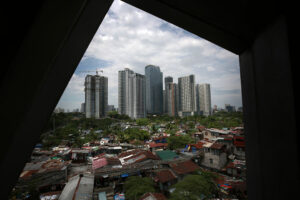




Quarterly Economic Growth Release: More BSP cuts to come
 DOWNLOAD
DOWNLOAD

Monthly Economic Update: Fed catches up
 DOWNLOAD
DOWNLOAD

Inflation Update: Steady and mellow
 DOWNLOAD
DOWNLOAD


DBCC won’t revise target ‘for now,’ says Balisacan

The Development Budget Coordination Committee (DBCC) is not planning to revise next year’s growth target “for now,” National Economic and Development Authority (NEDA) Secretary Arsenio M. Balisacan said.
“Until we see the numbers for this year, we won’t revise the numbers for next year,” he told reporters on the sidelines of the Philippine Economic Briefing on Monday.
The DBCC earlier tweaked its 2025 growth target to 6.5-7.5% from 6.5-8%.
Mr. Balisacan said the Philippine central bank’s “less hawkish” tone would affect consumption in the near term, but it would take longer to affect future investments.
Private spending accounts for nearly a quarter of gross domestic product (GDP) growth.
“[Rate cuts] could have immediate effects especially for those who are planning or have been planning to buy durable consumer goods,” he said.
“But for investments, that could have longer-term effects because if interest rates are expected to be lower in the coming months, investors may wait until (the cut) will materialize, and then it will take time before that actual investment will take place.”
Last week, the Monetary Board stood pat for the fifth straight meeting, keeping its key policy rate at a 17-year high of 6.5%. However, the BSP signaled a possible monetary easing by August.
Mr. Balisacan said a rate cut would also improve consumer expectations.
“If people expect that the interest rate will be lower in the coming months, then that makes people… preparing for that investment so that they will be ready to go to their banks.”
At the economic briefing, Finance Secretary Ralph G. Recto said the government must ramp up spending in infrastructure and human capital development programs to drive growth.
“These two investment areas will provide the highest multiplier effect in the short term and in the long term,” he said.
The Philippine economy grew by 5.7% in the first quarter despite weak consumption, inflation and high interest rates. The DBCC is targeting 6-7% growth this year.
Mr. Recto also cited the need to increase investments in education and social services.
“We aim to fully equip Filipinos with new technological know-how so we can position ourselves as the hub for technology-driven industries,” he added.
Stronger consumer spending fueled by remittance inflows and the expanding labor market would also bolster growth, Mr. Recto said.
The increasing number of Filipinos engaged in formal and stable jobs “reinforces the Philippines’ path towards becoming an upper middle-income country next year,” he added.
The Finance chief cited projections by multilateral lenders that the Philippine economy would outperform its Southeast Asian neighbors.
“By 2033, our economy will nearly triple in size, placing us in the league of economic giants like China, Japan, India and South Korea, and we are expected to continue outpacing the growth of Asia’s economic powerhouses in the years to come,” he said.
Meanwhile, Mr. Balisacan said sustained and inclusive growth would help reduce poverty incidence to 9% by 2028.
“We must also strengthen our social protection system [for] those who are unable to join the labor market because of their personal circumstances, or because they suffer certain shocks, like victims of typhoons or disasters,” he said.
“We should have a system that prevents them from going down the poverty line.”
Data from the Philippine Statistics Authority showed that the Philippines’ poverty incidence, or the proportion of poor Filipinos whose per capita income is not sufficient to meet their basic food and nonfood needs, fell to 22.4% in the first half of 2023 from 23.7% two years earlier.
This was equivalent to 25.242 million poor Filipinos, lower than 26.137 million in the first half of 2021. — By Beatriz Marie D. Cruz, Reporter
This article originally appeared on bworldonline.com





 By BusinessWorld
By BusinessWorld